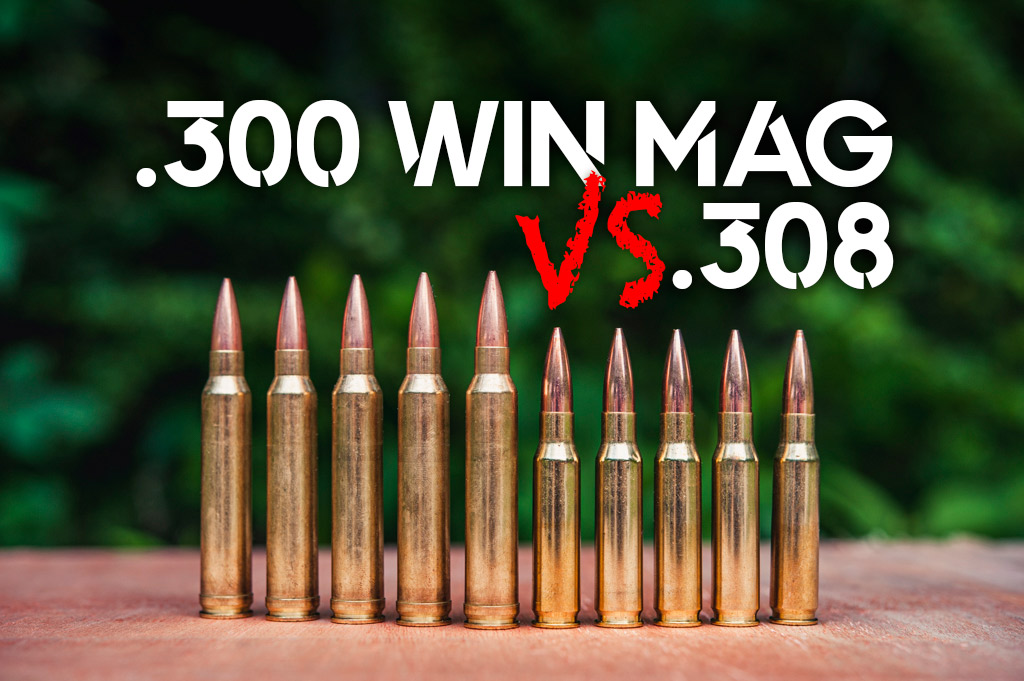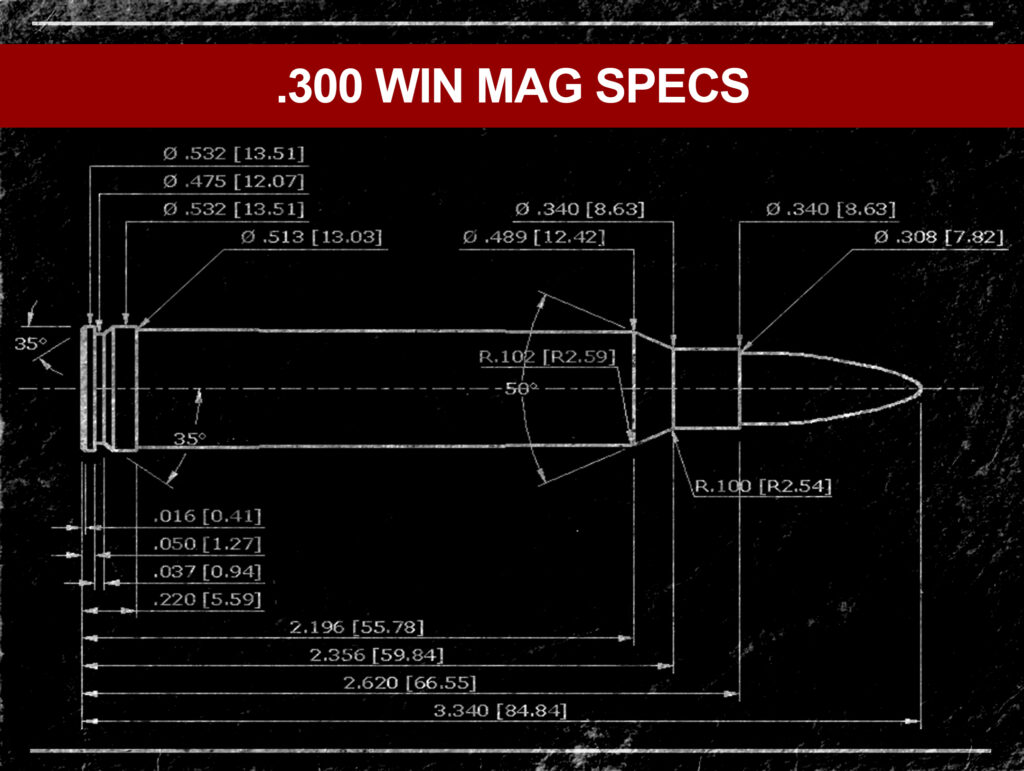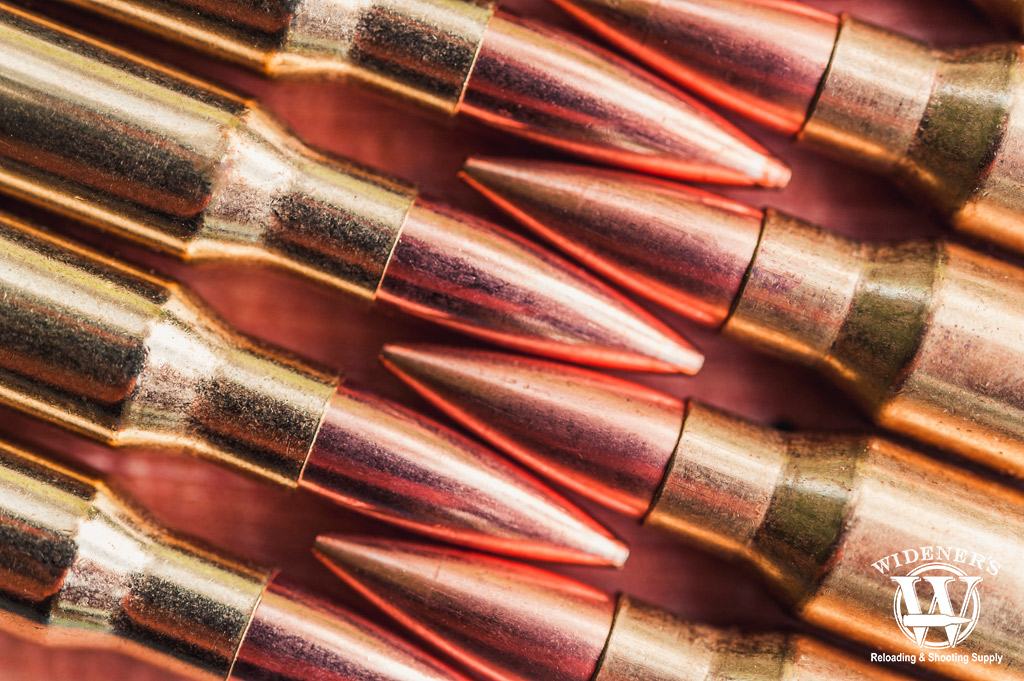

The 300 Win Mag and the 308 Win cartridges are precise, effective, and reliable. These rounds have been tried, and they’ve been found true. It’s not a discussion of 300 Win Mag VS 308 being better or worse. Rather, we will be inspecting each round’s purpose, strengths, and weaknesses.
The 300 Win Mag is built for distance and power. If you need it, use it. The 308 is a versatile round, a gritty adventurer ready to do whatever, whenever. Which is for you? That depends on your needs and personal preference.
Key Differences: 300 Win Mag VS 308
What are the differences between the 300 Win Mag and the 308? It comes down to the size of the case, the long-range capability, recoil, and more.
Differences between 300 Win Mag VS 308:
- Case size
- Power
- Recoil
- Price
- Short action
Let’s look at these in more depth.
Case Size: 300 Win Mag VS 308
The 300 Win mag is larger than the 308 and even a step up from the 30-06. The 300 Win Mag uses the same projectile, but the casing holds significantly more powder. This increase in case size is the main difference between the 308, and it allows the 300 Win mag to push bullets faster and further.
Cartridge Size Comparison
In this section, we’ll address some of the specs on the cartridge size for the 308 vs. the 300 Win Mag.
| Cartridge Specs | .300 Win Mag | .308 Win |
|---|---|---|
| Parent Casing | .375 HH Mag | .300 Savage |
| Bullet Diameter | .308″ | .308″ |
| Neck Diameter | .339″ | .3433″ |
| Base Diameter | .513″ | .4709″ |
| Case Length | 2.62″ | 2.015″ |
| Overall Length | 3.34″ | 2.8″ |
| Grain Weight | 150gr-220gr | 110gr-180gr |
| Max Pressure (SAMMI) | 64,000 PSI | 62,000 PSI |
Dimensions for the 308 Win:

The .308 Winchester is a short-action cartridge with a reduced powder capacity compared to the .300 Win Mag.
- Designed: 1952
- Designer: Winchester Repeating Arms Company
- Type: Rimless, Bottleneck Centerfire
- Case capacity: 56 grH2O
Dimensions for the 300 Win Mag:

The .300 Win Mag has the same bullet diameter as the .308 Win., however, its longer case makes it a long-action cartridge.
- Designed: 1963
- Designer: Winchester Repeating Arms Company
- Type: Belted, Bottleneck Centerfire
- Case capacity: 90.3 grH2O
As you can see, the case capacity is nearly double for the 300 Win Mag, giving it a clear advantage when pushing heavy bullets down the range. Here’s a video explaining the 308 and 300 Win Mag differences in cartridges.
Note: The 308 Win and the 300 Win Mag are not compatible cartridges, meaning you cannot interchange the rounds between rifles. Yes, the bullets are the same size, but the casings are very different. Seasoned gun owners know this, but it’s a relatively common question for those who are unfamiliar.
Power: 300 Win Mag VS 308
Along with the 300 Win Mag’s increased case size comes an increase in power. Some people believe that the 300 Win Mag is the clear choice over the 308 for bigger game, such as elk or moose. There’s an argument to be made; however, many people point out that unless you’re shooting past 400-500 yards (let’s be honest, not that common), the 308 is still a solid choice.
However, there are some who need the extra range and power, and in these cases the 300 Win Mag takes the blue ribbon.
Recoil Considerations
The 308 Winchester has less recoil than the 300-win mag. Whether the recoil is enough to keep someone away from the 300 Win Mag is a personal decision; however, it’s something to consider. When shooting the 180gr Nosler Partition bullet, the recoil for the 308 will be a felt 16.7 ft-lbs., and the recoil for the 300 Win Mag will be a felt 26.17 ft-lbs. That’s a big difference.
In this same vein, the 308 is built in more compact forms, making it easier to carry it for long periods. Of course, recoil and weight will vary based on the rifle and the shooter, so this might not be a make-or-break for some folks.
Ammo Pricing & Considerations
The 300 Win Mag ammunition is noticeably more expensive than the 308 Winchester. Also, 308 ammunition is a little easier to find. That’s not to say that 300 Win Mag ammunition is scarce, just that the 308 is slightly more prevalent, particularly in the far reaches of the world. As both cartridges use the same bullet, you’ll find they also share a similar variety of bullet types. From match-grade hollow points to soft points for hunting, and poly-tips for hunting, you’ll find a variety to meet your needs.
If you’re into reloading, you can buy .308 bullets now and decide which direction to head in once you’ve selected your brass. Of course, the .300 Win Mag brass is more expensive and somewhat more difficult to find. You’ll also be using more powder for those magnum loads, along with large rifle Magnum primers. The .308 Win might start to look like a discount round after tallying all those supplies up.
Similarities: 300 Win Mag VS 308

.308 Win (Left) has less recoil, while the .300 Win Mag (Right) has more power and energy.
The 308 and the 300 Win Mag do have similarities and were born in close proximity to each other, gaining popularity around the 1960s. Here are some of the similarities between the 308 and the 300 Win mag:
- Bullet Caliber
- Hunting rifles
- Long-range capability
Bullet Caliber Comparison
The 308 and the 300 Win Mag use the same sized .30 caliber bullet. In fact, as mentioned, if you do your own reloading, you can exchange the two bullets, which gives a level of continuity for reloaders with both rifles.
The 308 is a short-action cartridge, making it friendly to semi-automatic platforms, such as the standard AR-10. Combine the short action with the reduced recoil, and the 308 is a pretty manageable round for rapid firing. It’s no wonder many competition shooters have adopted it for run-and-gun-style matches.
300 Win Mag on the other hand is a standard long-action cartridge. It traditionally works well in precision bolt-action rifles, the kind you commonly find in the hands of hunters and long-distance shooters. Modern advancements have given the cartridge a new life in semi-auto rifles. A few manufacturers are producing modified AR-10 style rifles, chambered in 300 Win Mag.
Hunting Performance
Both the 308 and the 300 Win Mag have received widespread acclaim in the hunting world, particularly with big game. Both these cartridges are well suited for some of the biggest game in North America, with many hunters taking deer, elk, bear, and moose with both. Sure, the 300 Win Mag will give you an edge with bigger game at larger distances, but as many point out, it’s all about shot placement.
Long Range Capability
Yes, the 300 Win Mag will punch further than the 308; however, both are good distance shooters. They are accurate and reliable, and with practice, both have a maximum effective range beyond distances that most shooters can consistently hit. If you’re planning on hitting targets at 500 yards with either caliber, you’re going to need to practice and use match-grade ammo. At 1,000 yards, you can still do damage, although the 300 Win Mag pulls ahead of the .308 Win at that distance (the 300 Win Mag can, in the right circumstances, reach out and touch targets with efficiency at over a mile).
Best Uses: 300 Win Mag VS 308
Now, let’s talk about practical uses. If you could only choose one rifle cartridge, which would it be? The 308 or the 300 Win Mag? The answer depends on your needs and personal philosophy. Several categories to consider for the 308 and 300 Win Mag:
- Hunting
- Self Defense
- Target and competition
Hunting: 300 Win Mag VS 308
It would be silly to designate a “winner” in this category. Both rifles are proven in the hunting world. However, they each have strengths and weaknesses. If you’re hunting in wooded areas and your range will stay within 300 yards, you’ll do well with the 308. The rifle will give you plenty of power and less recoil.
However, past 400 yards, you’ll see the benefit of the 300 Win Mag. Some might argue the 300 Win mag has greater stopping power. However, the discussion about “stopping power” can spiral into the fourth dimension. Questions of ethics, tracking, and shot placement become a cog in the often-confusing world of stopping power. Let’s avoid the black hole and just say: larger calibers don’t make up for poor shot placement or poor training (for hunting or self-defense).
Self Defense Options
For self-defense, the 308 will give most people plenty of range, easier control, and more semi-automatic options than the 300 Win Mag. But the 300 Win Mag does provide some ultra-sniper range. If you’re looking for long-range capability, the 300 Win mag will certainly fit the bill. Someone who already has a 223 Rem (5.56) rifle may be tempted to skip the middleman and jump right to the bigger 300 Win Mag. However, the AR-10 platform makes a lot of sense chambered in .308 Win, if you’re already an AR-15 owner, it’s a more logical step up if you need additional firepower.
Target Practice & Competition
If you want an all-around rifle, one that hunts, defends, plinks on the weekend, and you can pass down to the kids, the 308 Winchester is a safe bet. Why? The recoil will be manageable by most shooters. The ammunition is relatively inexpensive compared to the 300 Win Mag, and the reduction in energy means a longer barrel life (all else being equal).
The 300 Win Mag will be an enjoyable rifle (if you don’t mind the kick). Certainly, for competition shooting, the 300 Win Mag’s increased velocity could give it an edge at especially long distances. With that said, the 308 has a long history of award-winning accuracy, partially due to lower recoil. Now, let’s talk numbers.
Ballistic Comparison: 300 Win Mag VS 308

Federal Fusion is specifically designed for deer hunting, the bonded soft point bullet expands rapidly in soft targets.
The 300 Win mag and the 308 show their differences at longer ranges. At 300 yards you begin to see discrepancies, at 500 yards the 300 Win mag pulls away. Once you get out there, you’ll notice that the 308 doesn’t maintain the same energy. The 308 can push a 180gr soft-point at a velocity of 2,600 FPS (at the muzzle). With that said, the 300 Win Mag can propel the same bullet at 2,960 FPS – that’s a faster speed with more energy behind it. The 308 bullet has a drop of 9.1″ at 300 yards and a drop of 51.9″ at 500 yards. In comparison, the same bullet in a 300 Win Mag casing has a drop of 6.7″ at 300 yards and a drop of 39.4″ at 500 yards.
180gr Comparison
| Caliber | Bullet Type | Bullet Weight | Velocity (Muzzle) | Energy (Muzzle) | 100 Yards (Velocity/Energy) | 200 Yards (Velocity/Energy) | 300 Yards (Velocity/Energy) |
|---|---|---|---|---|---|---|---|
| .300 Win Mag | Bonded SP | 180gr | 2,960 FPS | 3,502 FT LBS | 2,766 FPS/3,057 FT LBS | 2,580 FPS/2,659 FT LBS | 2,401 FPS/2,304 FT LBS |
| .308 Win | Bonded SP | 180gr | 2,600 FPS | 2,702 FT LBS | 2,427 FPS/2,354 FT LBS | 2,262 FPS/2,042 FT LBS | 2,101 FPS/1,763 FT LBS |

Federal Power-Shok ammo punches well above its price point, with deadly accuracy, and consistent expansion.
The 150gr Jacketed soft-point further illustrates this divide. The 308 can push the 150gr bullet at a velocity of 2,820 FPS (muzzle). While the 300 Win Mag can send the same bullet downrange at 3,150 FPS. Bullet energy tells a similar story, with the 300 Win Mag staying on top throughout the range. The 308 bullet has a drop of 8.8″ at 300 yards and a drop of 55.2″ at 500 yards. In comparison, the same bullet in a 300 Win Mag casing has a drop of 6.2″ at 300 yards and a drop of 37.5″ at 500 yards.
150gr Comparison
| Caliber | Bullet Type | Bullet Weight | Velocity (Muzzle) | Energy (Muzzle) | 100 Yards (Velocity/Energy) | 200 Yards (Velocity/Energy) | 300 Yards (Velocity/Energy) |
|---|---|---|---|---|---|---|---|
| .300 Win Mag | Jacketed SP | 150gr | 3,150 FPS | 3,305 FT LBS | 2,898 FPS/2,798 FT LBS | 2,661 FPS/2,358 FT LBS | 2,435 FPS/1,975 FT LBS |
| .308 Win | Jacketed SP | 150gr | 2,820 FPS | 2,648 FT LBS | 2,532 FPS/2,134 FT LBS | 2,261 FPS/1,702 FT LBS | 2,007 FPS/1,341 FT LBS |
These numbers will vary based on the ammunition, the weather conditions, and the barrel length (24″ test barrel used for the data above).
Best Choice: 300 Win Mag VS 308

Choose the .300 Win Mag for targets at a great distance, for everything else, the .308 Win is hard to beat.
The 308 and 300 Win Mag are both standout rounds. Neither is better or worse than the other.
The 300 Win Mag can reach longer ranges with more energy. At the end of the day, it can go places the 308 Win simply can’t reach effectively. However, you’ll pay for it with a kick and the price of the ammunition. The same goes for getting a good bolt-action rifle, you’ll want to pay up for a good barrel to make the magnum ammo perform. Again, you can find semi-auto rifles chambered in 300 Win Mag, however, expect to pay a premium to obtain one.
The 308 Win still has plenty of distance for most hunting and self-defense scenarios. With the 308, you get a versatile cartridge that can precisely harvest large and small game. The ammo is easy to find, even in surplus. The same argument could be made for brass and reloading components. You get more gun options as well, including the popular semi-auto AR-10 platform from several manufacturers. Ultimately, the choice is yours.
If one of these cartridges grabbed your attention, you can read more about each in our individual guides to the best 308 ammunition or the best 300 Winchester Magnum ammunition.


